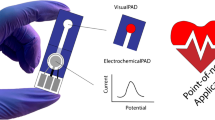Abstract
A clinical methylcellulose sampling strip is one of the popular means for collecting gingival crevicular fluid (GCF) from dental patients for dental disease diagnosis. In this research, a microfluidic device for protein elution from a sampling strip was fabricated with poly (dimethylsiloxane) (PDMS) polymer. Electoelution experiments were performed with fluorescein isothiocyanate (FITC) dye labeled bovine serum albumin (BSA) and ovalbumin (OVA). The total amount of eluted protein is measured by quantitative fluorescence imaging. About 50% of the initial concentration of BSA and OVA was eluted by the ~20 V/cm electric field. Electroelution is an appealing method for protein elution; however, the thickness of the wet strip (~400 μm) introduces interesting practical difficulties. During the electroelution process, unsteady electrokinetic phenomena by the pressure driven flow and the pH change of the reservoirs were observed. Several possible solutions to these problems are still under investigation including modifying reservoirs and thin polymer film coating of PDMS channel surfaces. This electroelution device would be a useful component of a fully integrated micro total analysis system for oral fluid samples.





Similar content being viewed by others
References
Ahokas H (1987) Electroelution of nucleic-acid in microcentrifuge tube. Nucleic Acids Res 15(16):6759. doi:10.1093/nar/15.16.6759
Anderson JR, Chiu DT, Jackman RJ, Cherniavskaya O, McDonald JC, Wu HK, Whitesides SH, Whitesides GM (2000) Fabrication of topologically complex three-dimensional microfluidic systems in pdms by rapid prototyping. Anal Chem 72(14):3158–3164. doi:10.1021/ac9912294
Antal J, Bányász B, Buzás Z (2007) Shotgun electroelution: A proteomic tool for simultaneous sample elution from whole sds-polyacrylamide gel slabs. Electrophoresis 28(4):508–511. doi:10.1002/elps.200600634
Basak SK, Ladisch MR (1995) Correlation of electrophoretic mobilities of proteins and peptides with their physicochemical properties. Anal Biochem 226(1):51–58. doi:10.1006/abio.1995.1190
Burns MA, Johnson BN, Brahmasandra SN, Handique K, Webster JR, Krishnan M, Sammarco TS, Man PM, Jones D, Heldsinger D, Mastrangelo CH, Burke DT (1998) An integrated nanoliter DNA analysis device. Science 282(5388):484–487. doi:10.1126/science.282.5388.484
Chang T, Tsai IH, Chang WC (1987) Electroelution of DNA and protein from polyacrylamide and agarose gels. Biochem Int 15(4):687–691
Chang HT, Yergey AL, Chrambach A (2001) Electroelution of proteins from bands in gel electrophoresis without gel sectioning for the purpose of protein transfer into mass spectrometry: Elements of a new procedure. Electrophoresis 22(3):394–398. doi:10.1002/1522-2683(200102)22:3<394::AID-ELPS394>3.0.CO;2-X
Effenhauser CS, Bruin GJM, Paulus A, Ehrat M (1997) Integrated capillary electrophoresis on flexible silicone microdevices: Analysis of DNA restriction fragments and detection of single DNA molecules on microchips. Anal Chem 69(17):3451–3457. doi:10.1021/ac9703919
Folch A, Ayon A, Hurtado O, Schmidt MA, Toner M (1999) Molding of deep polydimethylsiloxane microstructures for microfluidics and biological applications. J Biomech Eng 121(1):28–34. doi:10.1115/1.2798038
Giannobile WV, Lynch SE, Denmark RG, Paquette DW, Fiorellini JP, Williams RC (1995) Crevicular fluid osteocalcin and pyridinoline cross-linked carboxyterminal telopeptide of type-i collagen (ictp) as markers of rapid bone turnover in periodontitis—a pilot-study in beagle dogs. J Clin Periodontol 22(12):903–910. doi:10.1111/j.1600-051X.1995.tb01793.x
Griffiths GS (2003) Formation, collection and significance of gingival crevice fluid. Periodontol 2000 31:32–42. doi:10.1034/j.1600-0757.2003.03103.x
Harrison DJ, Fluri K, Seiler K, Fan ZH, Effenhauser CS, Manz A (1993) Micromachining a miniaturized capillary electrophoresis-based chemical-analysis system on a chip. Science 261(5123):895–897. doi:10.1126/science.261.5123.895
Herr AE, Hatch AV, Throckmorton DJ, Tran HM, Brennan JS, Giannobile WV, Singh AK (2007) Microfluidic immunoassays as rapid saliva-based clinical diagnostics. Proc Natl Acad Sci USA 104(13):5268–5273. doi:10.1073/pnas.0607254104
Hu SW, Ren XQ, Bachman M, Sims CE, Li GP, Allbritton N (2002) Surface modification of poly(dimethylsiloxane) microfluidic devices by ultraviolet polymer grafting. Anal Chem 74(16):4117–4123. doi:10.1021/ac025700w
Kirby BJ, Wheeler AR, Zare RN, Fruetel JA, Shepodd TJ (2003) Programmable modification of cell adhesion and zeta potential in silica microchips. Lab Chip 3(1):5–10. doi:10.1039/b210621n
Manz A, Graber N, Widmer HM (1990) Miniaturized total chemical-analysis systems—a novel concept for chemical sensing. Sens Actuat B 1(1–6):244–248
McDonald JC, Duffy DC, Anderson JR, Chiu DT, Wu HK, Schueller OJA, Whitesides GM (2000) Fabrication of microfluidic systems in poly(dimethylsiloxane). Electrophoresis 21(1):27–40. doi:10.1002/(SICI)1522-2683(20000101)21:1<27::AID-ELPS27>3.0.CO;2-C
McDonald JC, Metallo SJ, Whitesides GM (2001) Fabrication of a configurable, single-use microfluidic device. Anal Chem 73(23):5645–5650. doi:10.1021/ac010631r
Pal R, Yang M, Lin R, Johnson BN, Srivastava N, Razzacki SZ, Chomistek KJ, Heldsinger DC, Haque RM, Ugaz VM, Thwar PK, Chen Z, Alfano K, Yim MB, Krishnan M, Fuller AO, Larson RG, Burke DT, Burns MA (2005) An integrated microfluidic device for influenza and other genetic analyses. Lab Chip 5(10):1024–1032. doi:10.1039/b505994a
Pastushenko VP (1997) Teorell’s membrane system oscillates at constant voltage. Bioelectrochem Bioenerg 43(1):143–150. doi:10.1016/S0302-4598(96)05168-9
Ren XQ, Bachman M, Sims C, Li GP, Allbritton N (2001) Electroosmotic properties of microfluidic channels composed of poly(dimethylsiloxane). J Chromatogr B Analyt Technol Biomed Life Sci 762(2):117–125. doi:10.1016/S0378-4347(01)00327-9
Sanders GHW, Manz A (2000) Chip-based microsystems for genomic and proteomic analysis. Trac Trends Anal Chem 19(6):364–378. doi:10.1016/S0165-9936(00)00011-X
Schmalzing D, Adourian A, Koutny L, Ziaugra L, Matsudaira P, Ehrlich D (1998) DNA sequencing on microfabricated electrophoretic devices. Anal Chem 70(11):2303–2310. doi:10.1021/ac971381a
Schulte TH, Bardell RL, Weigl BH (2002) Microfluidic technologies in clinical diagnostics. Clin Chim Acta 321(1–2):1–10. doi:10.1016/S0009-8981(02)00093-1
Vandenberg A, Grisel A, Verneynorberg E, Vanderschoot BH, Koudelkahep M, Derooij NF (1993) On-wafer fabricated free-chlorine sensor with ppb detection limit for drinking-water monitoring. Sens Actuat B 13(1–3):396–399. doi:10.1016/0925-4005(93)85410-C
Vanderschoot BH, Vandenvlekkert HH, Derooij NF, Vandenberg A, Grisel A (1991) A flow-injection analysis system with glass-bonded isfets for the simultaneous detection of calcium and potassium-ions and ph. Sens Actuat B 4(3–4):239–241. doi:10.1016/0925-4005(91)80116-2
Acknowledgment
This work was financially supported by INHA UNIVERSITY Research Grant for Sun Min Kim.
Author information
Authors and Affiliations
Corresponding author
Rights and permissions
About this article
Cite this article
Kim, S.M. Microfluidic system for electroelution of proteins from a clinical sampling strip. Microsyst Technol 15, 695–701 (2009). https://doi.org/10.1007/s00542-009-0781-x
Received:
Accepted:
Published:
Issue Date:
DOI: https://doi.org/10.1007/s00542-009-0781-x




